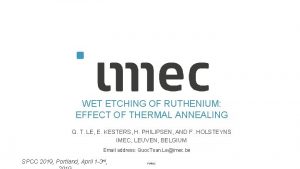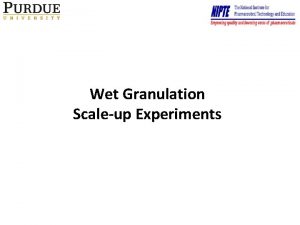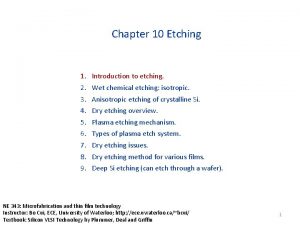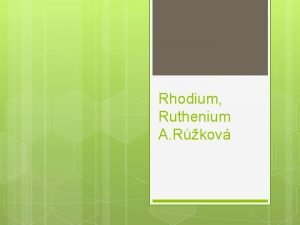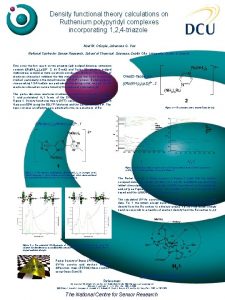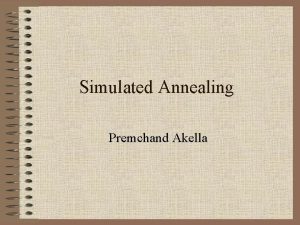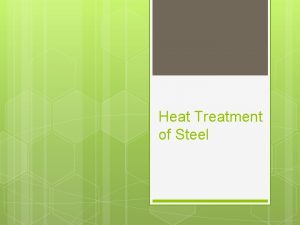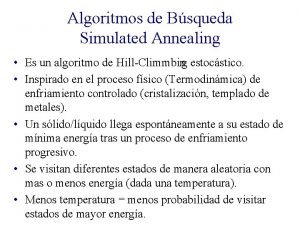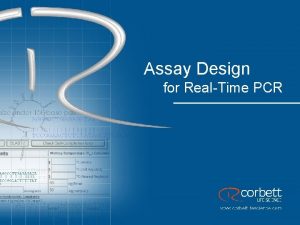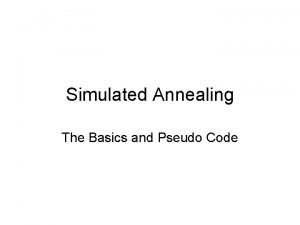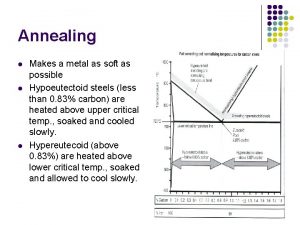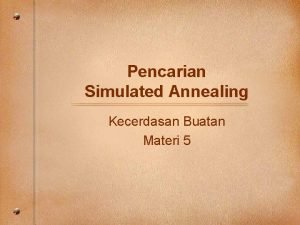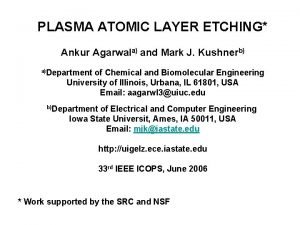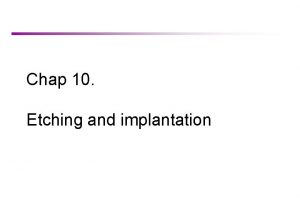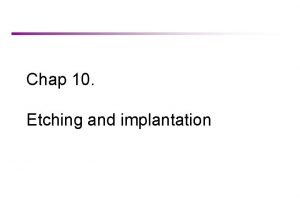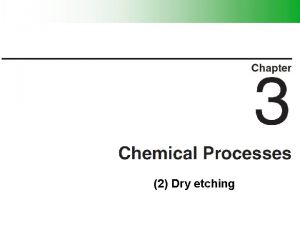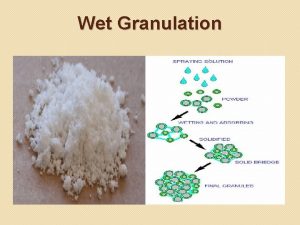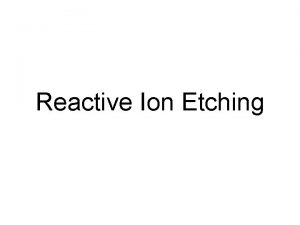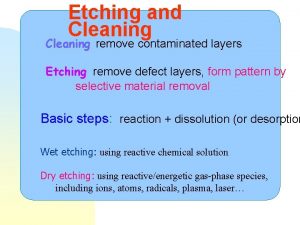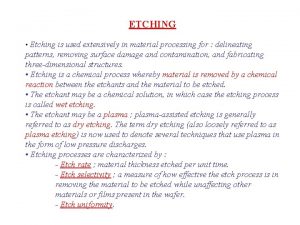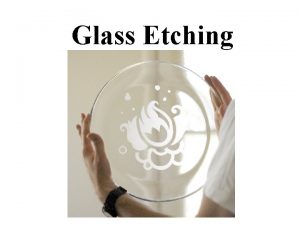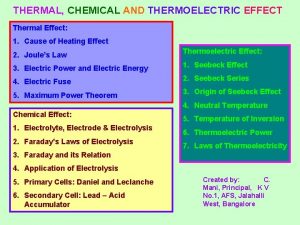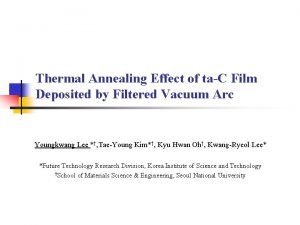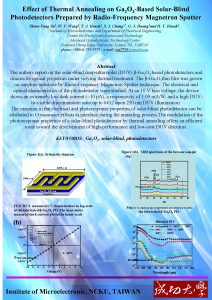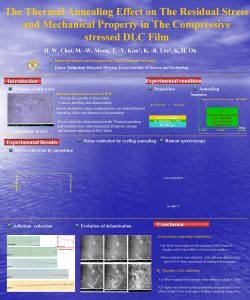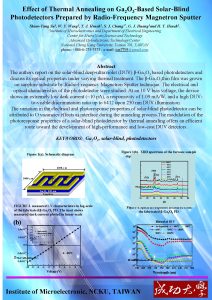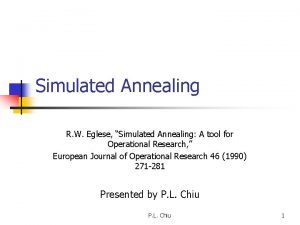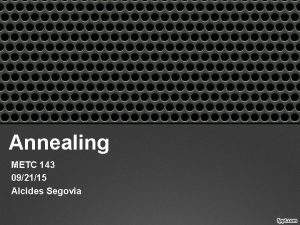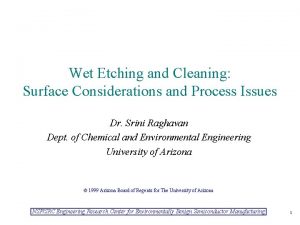WET ETCHING OF RUTHENIUM EFFECT OF THERMAL ANNEALING



![RUTHENIUM: METAL OF CHOICE FOR BEOL INTERCONNECT R [W/mm] § Ru: Interconnect alternative to RUTHENIUM: METAL OF CHOICE FOR BEOL INTERCONNECT R [W/mm] § Ru: Interconnect alternative to](https://slidetodoc.com/presentation_image_h/a2f10e7af78281bdf3da92ef2871d9b7/image-4.jpg)

















- Slides: 21

WET ETCHING OF RUTHENIUM: EFFECT OF THERMAL ANNEALING Q. T. LE, E. KESTERS, H. PHILIPSEN, AND F. HOLSTEYNS IMEC, LEUVEN, BELGIUM Email address: Quoc. Toan. Le@imec. be SPCC 2019, Portland, April 1 -3 rd, PUBLIC

OUTLINE Introduction to metal recess etch for Fully self-aligned via (FSAV) application Etching of “bulk” Ruthenium Effect of annealing on blanket Ru etching XPS and X-SEM characterization Etching of Ru liner Effect of annealing on Ru liner etching XPS depth profiling Etching of Ru liner using commodity chemical mixtures Summary Q. T. Le et al. , SPCC 2019, Portland, April 1 -3 rd, 2019 2

METAL RECESS ETCH FOR FULLY SELF-ALIGNED VIA (FSAV) APPLICATION Objective: controlled recess etch of metal selectively to other materials in the stack Metal Liner/barrie r Dielectric Bottom HM M 1 Recess M 1 CMP Example of metals and liner/barrier: Metal = Cu; Liner/barrier = Ru/ Ta. N Q. T. Le et al. , SPCC 2019, Portland, April 1 -3 Metal = Ru; Barrier = Ta. N or Ti. N Metal barrier etch Co recess: A. Pacco et al. , SPCC 2019 rd, 2019 3
![RUTHENIUM METAL OF CHOICE FOR BEOL INTERCONNECT R Wmm Ru Interconnect alternative to RUTHENIUM: METAL OF CHOICE FOR BEOL INTERCONNECT R [W/mm] § Ru: Interconnect alternative to](https://slidetodoc.com/presentation_image_h/a2f10e7af78281bdf3da92ef2871d9b7/image-4.jpg)
RUTHENIUM: METAL OF CHOICE FOR BEOL INTERCONNECT R [W/mm] § Ru: Interconnect alternative to Cu § Candidate as barrier-less metallization for interconnect § Ru vs. Cu: Ru outperforms Cu both for line and via resistance below 12 nm CD § Ru has been used as a liner layer Line CD [nm] Q. T. Le et al. , SPCC 2019, Portland, April 1 -3 rd, 2019 4 o M. van der Veen et al. , IITC 2018. o H. Philipsen et al. , Electrochimica Acta (2018), https: //doi. org/10. 1016/j. electacta. 2018. 04. 093 o H. Philipsen et al. , Electrochimica Acta (2019), https: //doi. org/10. 1016/j. electacta. 2019. 03. 065

ETCHING OF “BULK” RUTHENIUM

ETCHING OF Ru USING HYPOCHLORITE SOLUTION Correlation between Rs and Ru thickness o H. Philipsen et al. , Electrochimica Acta (2019), https: //doi. org/10. 1016 /j. electacta. 2019. 03. 065 See also T. Ohashi et al. , SPCC 2019 § Annealing at elevated temperature (420 ºC) significantly affected Ru etch rate § Annealing made the Ru film more chemical resistant § Ru etch rate is inversely proportional to annealing temperature § Possible mechanism § Bulk change (crystallinity, grain size) , 2019 § Change of surface chemistry Q. T. Le et al. , SPCC 2019, Portland, April 1 -3 rd 6

EFFECT OF ANNEALING ON Ru ETCH: XPS As-deposited Ru Annealed Ru (420 °C) Ru 3 d + C 1 s O 1 s Reference Ru 3 d + C 1 s Reference O 1 s C 1 s Ta 4 p Ru 3 d + C 1 s Ta 4 f 2% Na. OCl/ 5 min § Ta is detected for the as-depo Ru/ 5 min immersion in Na. OCl Ru was removed Q. T. Le et al. , SPCC 2019, Portland, April 1 -3 rd, 2019 § 420 °C-annealed Ru was not etched in 2% Na. OCl/ 5 min 7

EFFECT OF ANNEALING ON Ru ETCH: XPS ATOMIC CONCENTRATION (At. %) As-depo. Ru Annealed Ru CVD-Ru + anneal + 5 min Na. OCl § § O Ru Ru Ru C N Ru. O 2 Ru. Oy 24. 4 10. 9 5. 1 4. 3 54. 1 1. 2 29. 9 5. 7 4. 7 53. 3 0. 6 29. 4 5. 6 4. 5 54. 4 0. 6 As-deposited Ru: after immersion in Na. OCl solution: only a thin Ru. O 2 layer remained at the surface Annealed Ru is significantly oxidized compared to the as-deposited Ru § The presence of Ru. O 2 at the surface prevents/ slows down the etching of Ru layer after annealing Annealing at elevated temperature (420 °C) significantly affected Ru etch rate Q. T. Le et al. , SPCC 2019, Portland, April 1 -3 rd, 2019 8

XPS CHARACTERIZATION – Ru 3 d XPS database Ru 3 d 3/2 and C 1 s Ru Ru 3 d 3/2 Ru. O 2 Ru 3 d 5/2 Ru Ru. O 2 Ru 3 d 5/2 § Main effect of thermal annealing: formation of oxidized Ru at the surface § The presence of Ru oxide layer is more noticeable when spectra are collected at higher electron take-off angle (more surface sensitive) Q. T. Le et al. , SPCC 2019, Portland, April 1 -3 rd, 2019 9 https: //xpssimplified. com/eleme nts/ruthenium. php

XPS CHARACTERIZATION – O 1 s § O 1 s intensity increased after annealing at 420 °C § Significant different spectra for surface and bulk spectra § Oxidized Ru is only present at the surface § In addition to Ru. O 2, presence of other Ru with higher oxidation states Q. T. Le et al. , SPCC 2019, Portland, April 1 -3 rd, 2019 10

Ru RECESS ETCH Blanket annealed Ru (420 ºC) Patterned annealed Ru (420 ºC) Incoming structure p. H ~9/ 60 s Thickness change ~5 nm Only focused at p. H >7 to avoid formation of Ru. O 4 See for example, T. Oshahi et al. , SPCC 2019 Q. T. Le et al. , SPCC 2019, Portland, April 1 -3 rd, 2019 § Ru in trenches was partially etched § Rougher surface vs. incoming surface § Non uniform recess 11

ETCHING OF RUTHENIUM LINER

Cu RECESS AND Ru LINER ETCH FLOW SHORT-LOOP STRUCTURE: Cu FILL/ Ru LINER/ Ta. N BARRIER 1. Cu CMP Cu 2 & 3. Cu recess and Ru liner Etch Ru Liner/barrier 4. Ta. N barrier Etch Dielectric Q. T. Le et al. , SPCC 2019, Portland, April 1 -3 rd, 2019 Fully self-align via integration o G. Murdoch et al. , IITC 2017. o B. D. Briggs et al. , IEEE IEDM 2017. 13

ETCHING OF Ru LINER IN PATTERNED STRUCTURE § Na. OCl (2 -5%) was not efficient for sidewall liner Ru removal (1 -2 nm): Ru liner layer was not etched § Ru profile is very similar to N profile § Possible intermixing of Ru and Ta. N at the interface. Possibly, formation of Ru. Nx and/or Ru. Tax. Ny compound due to annealing. Stripping onset potential for Ru compound is different vs. metallic Ru Q. T. Le et al. , SPCC 2019, Portland, April 1 -3 , 2019 rd 14

EFFECT OF ANNEALING: XPS DEPTH PROFILES § Annealed at 400 °C resulted in major difference § Ru-Ta. N interface is much broader § Formation of an intermixing and/or compound of Ru-Ta could explain the different etching behavior of Ru at the interface Q. T. Le et al. , SPCC 2019, Portland, April 1 -3 rd, 2019 15 9 nm Cu 2 nm Ru 3 nm Ta. N Si

SURFACE ROUGHNESS AND RECESS DEPTH EVALUATION Incoming blanket Cu surface p. H 8 -8. 5 p. H 9 -9. 5 (H 2 O 2 + 0. 05% HF*) 4 cycles * HF with saturated DO RMS = 1. 20 Immersion time = 0 nm s Incoming Shortloop cross section 1. 15 nm 120 s 1. 22 nm 120 s Cu line CD ~20 nm Si. O 2 p. H 8 -8. 5 p. H 9 -9. 5 Q. T. Le et al. , SPCC 2019, Portland, April 1 -3 rd, 2019 16 RMS = 2. 37 nm § H 2 O 2 treatment followed by 0. 05% HF etch: high surface roughness § Promising results for Cond. 4 and Cond. 5

SIMULTANEOUS Cu AND Ru LINER ETCH: TEM RESULTS § Cu lines with CD ~20 nm § Estimation of Cu recess ~7 -9 nm § Simultaneous Cu recess and Ru liner etch demonstrated Q. T. Le et al. , SPCC 2019, Portland, April 1 -3 rd, 2019 17

SUMMARY

SUMMARY § Thermal annealing at 420 ºC made Ru more resistant to wet etch § “Bulk” Ru § Presence of an oxidized Ru layer at the surface strongly affected the etch rate § Annealed Ru can be etched by Na. OCl-based chemistry, however it resulted in rough Ru surfaces § Thin layer of Ru (Ru liner) § Formation of an intermixing and/or compound at the interface could explain the different etching behavior of Ru tuning of the etch chemicals, p. H, and composition required § Remark Q. T. Le et al. , SPCC 2019, Portland, April 1 -3 rd, 2019 § Different grain sizes different grain boundary density § Surface roughness after wet etching § Etch uniformity 19

ACKNOWLEDGEMENTS Integration: Chris Wilson, Gayle Murdoch, Guillaume Boccardi Surface and Interface Processing and CMP: Antoine Pacco, Nancy Heylen, Katia Devriendt Characterization (XPS, AFM, TEM, RBS): Thierry Conard, Ilse Hoflijk, Inge Vaesen, Danielle Vanhaeren, Stefanie Sergeant, Eric Vancoille, Kris Paulussen, Laura Nelissen, Hugo Bender, Johan Meersschaut, Johan Desmet Q. T. Le et al. , SPCC 2019, Portland, April 1 -3 rd, 2019 20

PUBLIC
 Isotropic material
Isotropic material Wet etching vs dry etching
Wet etching vs dry etching Self aligned via
Self aligned via Wet wet wet
Wet wet wet Wet etching
Wet etching Rhodium vs ruthenium
Rhodium vs ruthenium Ruthenium
Ruthenium Diagram cct
Diagram cct Annealing
Annealing Full annealing definition
Full annealing definition Algoritmo
Algoritmo Pcr annealing temperature too high
Pcr annealing temperature too high Taqman gene expression assay
Taqman gene expression assay Annealing
Annealing Simulated annealing pseudocode
Simulated annealing pseudocode Spheroidising
Spheroidising Normalising and annealing
Normalising and annealing Contoh simulated annealing
Contoh simulated annealing Section 3 using heat worksheet answers
Section 3 using heat worksheet answers Thermal transfer vs direct thermal printing
Thermal transfer vs direct thermal printing Atomic layer etching
Atomic layer etching Serial number restoration process
Serial number restoration process


